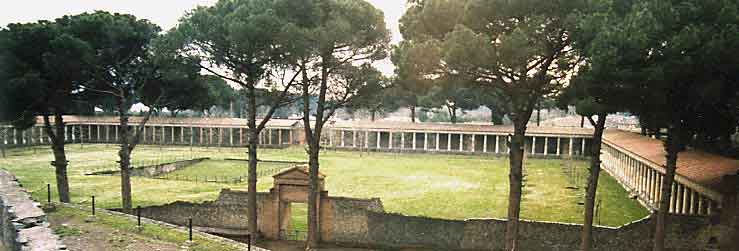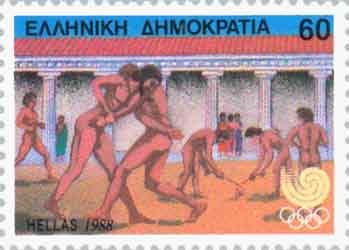.

Pompeii palaestra seen from the top of the stadium wall. The depression center left was filled with water and used for swimming practice and mock naval battles. To the right (partially obscured by a tree trunk) is a line of carbonized tree stumps, the remains of the trees (each one hundreds of years old) of the palaestra burned in the volcanic eruption of 79. Between them and the colonnade, a line of saplings recently planted as replacement.
The palaestra was the ancient Greek wrestling school. The events that did not require a lot of space, such as boxing and wrestling, were practiced there. The palaestra functioned both independently and as a part of public gymnasia. A palaestra could exist without a gymnasium, but no gymnasium can exist without a palaestra.

The Palaestra as an Athletic, Cultural and Social Center
The palaestra was a prominent feature in Greek society, the significance of athletic competition - and by extension, physical beauty - translating into the importance of the building itself. The status of the specific event, wrestling, sponsored by the palaestra added to the importance of the building. Wrestling was one of the oldest and most widely distributed sports in the Greek world.
Over time, the palaestra's role as an educational and social space also increased. Although the palaestra continued to function as the wrestling school, lectures and intellectual conversation were hosted there as well, and this educational role gradually took over the function of the building. The grounds and buildings of the palaestra were decorated with statues of famous athletes and gods and heroes such as Apollo, Hercules, and Hermes. Eros was also included, to honor the "oldest god" and the one who ruled over the friendships which men and youths often cemented in the environment of the palaestra. Music was often part of the proceedings and the competitions.
Architecture of the Palaestra
The architecture of the palaestra, although allowing for some variation, followed a distinct, standard plan. The palaestra essentially consisted of a rectangular court surrounded by colonnades with adjoining rooms. These rooms might house a variety of functions: bathing, ball playing, undressing and storage of clothes, seating for socializing, observation, or instruction, and storage of oil, dust or athletic equipment. Vitruvius, through his text On Architecture, is an important ancient source about this building type and provides many details about what he calls ?palaistra, Greek-style?. Although the specifics of his descriptions do not always correspond to the architectural evidence, probably because he was writing around 27 BC, his account provides insight into the general design and uses of this type of space. As Vitruvius describes, the palaestra was square or rectangular in shape with colonnades along all four sides creating porticoes. The portico on the northern side of the palaestra was of double depth to protect against the weather. Spacious halls (exedrae) were built along the single depth sides of the palaestra with seats for those enjoying intellectual pursuits, and the double depth side was divided into an area for youth activities (ephebeum), a punching bag area (coryceum), a room for applying powders (conisterium), a room for cold bathing, and an oil storeroom (elaeothesium).
Good examples of this building type come from two major Greek sites: Olympia and Delphi.
Vitruvius:
THE PALAESTRA
1. Though not used by the people of Italy, it seems proper that I should explain the form of the palæstra, and describe the mode in which it was constructed by the Greeks. The square or oblong peristylia of palestræ, have a walk round them which the Greeks call divauloV, two stadia in circuit: three of the sides are single porticos: the fourth, which is that on the south side, is to be double, so that when showers fall in windy weather, the drops may not drive into the inner part of it.
2. In the three porticos are large recesses (exedræ) with seats therein, whereon the philosophers, rhetoricians, and others who delight in study, may sit and dispute. In the double portico the following provision is to be made: the ephebeum is to be in the middle, which is in truth nothing more than a large exedra with seats, and longer by one third than its width, on the right is the coriceum, immediately adjoining which is the conisterium, near which, in the angle of the portico, is the cold bath, which the Greeks call loutrovn. On the left of the ephebeum is the elæothesium, adjoining that is the frigidarium , whence a passage leads to the propigneum in the angle of the portico. Near, but more inward, on the side of the frigidarium, is placed the vaulted sudatory, whose length is double its width; on one side of this is the laconicum, constructed as before described: on the other side is the hot bath.
3. The peristylia of the palæstra are to be carefully set out as above mentioned. Exteriorly three porticos are constructed, one through which those who come out of the palæstra pass; and stadial ones on the right and left, of which, that towards the north is double, and of considerable width. The other is single, and so formed that as well on the side next the wall, as on that where the columns stand, there are margins for paths of not less than ten feet, the centre part is sunkone foot and a half from the path, to which there is an ascent of two steps; the sunken part is not to be less than twelve feet in width. Thus, those who in their clothing walk round the paths, will not be incommoded by the anointed wrestlers who are practising.
4. This species of portico is called xystus (xusto`V) by the Greeks; for the wrestlers exercise in covered stadia in the winter time. Xysti ought, between the two porticos, to have groves or plantations, with walks between the trees and seat of cemented work. On the sides of the xystus and double portico are open walks which the Greeks call peridrovmideV, but with us they are termed xysti, on which the athletæ exercise themselves, when the weather is fine, in the winter. Behind the xystus the stadium is set out, of such dimensions that a great number of people may commodiously behold the contending wrestlers. I have now given rules for the proper distribution of such buildings as are within the walls.
Related articles
The Afternoon at the Gymnasia.
Related links
| Ancient Greece
Science, Technology , Medicine , Warfare, , Biographies , Life , Cities/Places/Maps , Arts , Literature , Philosophy ,Olympics, Mythology , History , Images Medieval Greece / Byzantine Empire Science, Technology, Arts, , Warfare , Literature, Biographies, Icons, History Modern Greece Cities, Islands, Regions, Fauna/Flora ,Biographies , History , Warfare, Science/Technology, Literature, Music , Arts , Film/Actors , Sport , Fashion --- |
Retrieved from "http://en.wikipedia.org"
All text is available under the terms of the GNU Free Documentation License

